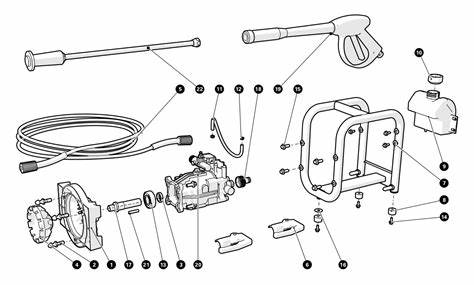Locating Pressure Washer Components A pressure washer serves as an excellent tool for thoroughly cleaning the exterior of your residence and yard. However, akin to any apparatus, its constituent parts undergo gradual wear and tear, necessitating eventual replacement or upgrading.
In this discussion, we will concentrate on electric and light-duty gas-powered pressure washers, predominantly employed by do-it-yourself (DIY) enthusiasts. In the event that a particular component is not readily available, the likelihood of finding it online or at a specialized store is quite high. A recommended initial step involves inquiring at the establishment where the pressure washer was originally purchased.
We shall elucidate the pressure washer components that are most frequently subject to replacement, elaborate on techniques for accurately identifying suitable replacement parts, and provide approximate cost estimates.

1.Nozzle Tips
Nozzle tips may experience damage, loss, or wear over time. The compatibility of nozzles largely depends on the size and type of the connector, as well as the pressure washer’s PSI (pounds per square inch) rating. If uncertain about these specifics, referring to the user manual is advisable. In the absence of a manual, conducting an internet search is recommended, as many manufacturers and third parties make manuals available online. Given that nozzle tips are frequently interchanged, most are designed for quick connect couplings. It is prudent to look for the abbreviation ‘QC’ in the product description to confirm quick connect compatibility.
2.Spray Guns
The handheld control device on a pressure washer is known as a spray gun. While various designs exist, in most instances, pressurized water is directed from the pump to the rear of the gun, where a ball valve holds it in place. Pulling the trigger activates the valve, enabling the water to be released through the front of the gun. Similar to nozzle tips, it is important to ensure that a replacement spray gun is compatible with the connectors and PSI rating of your pressure washer. A notable example is the replacement spray gun offered by Mingle. It is worth examining due to the informative images provided, illustrating the necessary measurements for determining compatibility. Additionally, this product is supplied with a pair of interchangeable rear connectors, each compatible with a different set of manufacturers.
3.Lances and Wands
In pressure washer applications, spray guns can be directly used in conjunction with a nozzle tip or an extension device known as a lance or wand. (If the spray gun integrates an extension, the entire assembly may be referred to as a wand.) It is imperative to replace a bent or damaged wand. Fundamental pressure washer wands typically consist of straight tubes with a screw-on adapter for gun connection and a nozzle connection at the other end. An illustrative example of a wand extension is the Surface MaxxPro wand. It is important to note that it utilizes an M-22 male adapter for gun connection; thus, confirming compatibility with existing hardware is advised.
4.Power Washer Pumps
While the spray gun serves as the control interface, the pump functions as the core of a pressure washer. Driven by the engine, the pump is responsible for generating pressure, transforming ordinary garden hose water into a potent cleaning spray. The majority of pressure washer pumps share essential components, yet discrepancies exist in manufacturing and machining, rendering the parts of one model incompatible with another.
5.Power Washer Engines
Residential pressure washers are primarily classified into two types: electric-powered and gas-powered. Irrespective of the power source, the functionality of the engine is crucial; without it, a pressure washer cannot generate pressure. In case the engine encounters issues, it can either be repaired or replaced. Generally, electrical motors pose more challenges for repairs. While specific components such as a GFCI plug can be replaced, most electrical pressure washer engines are designed for replacement rather than repair. Conversely, gas engines are more conducive to DIY repairs.
6.Hoses
Pressure washer hoses endure considerable stress. They are subjected to harsh conditions, dragged over rugged surfaces, forced into tight bends, and filled with pressurized liquids, ultimately leading to wear and tear. A replacement hose with a diameter of 1/4 inch, exemplified by this 50-foot Flexzilla, meets specifications of 3,100 PSI. If the pressure washer operates at a higher PSI, opting for a thicker 3/8-inch hose is advisable. Maintaining the same diameter as the original hose that came with the washer is generally a suitable choice.
7.Cart and Frame Components
Pressure washers possess considerable weight due to components such as the motor, pump, coiled hose, and various accessories. To enhance mobility and ease of use, it is essential for the unit to be mounted on a frame with wheels. However, if these wheels become damaged or the frame weakens, the efficiency and utility of the pressure washer can be significantly compromised. Replacing a broken wheel or axle is a relatively straightforward task. Simply measure the diameter of the original component and proceed to locate suitable replacements at a local hardware store. Strive to find a match with the original specifications; however, a replacement akin to this 10-inch rubber tire is likely to function adequately.
8.Filters and Inlets
Filtration plays a pivotal role in the functionality of most engine types, and pressure washers are no exception. Gas engines in pressure washers necessitate regular oil changes and air filter replacements. In addition to these, pressure washers are equipped with another critical filter—the pump’s intake filter connected to the garden hose. This pressure water filter aids in bubble dispersion and serves to prevent the entry of foreign particles into the pump.